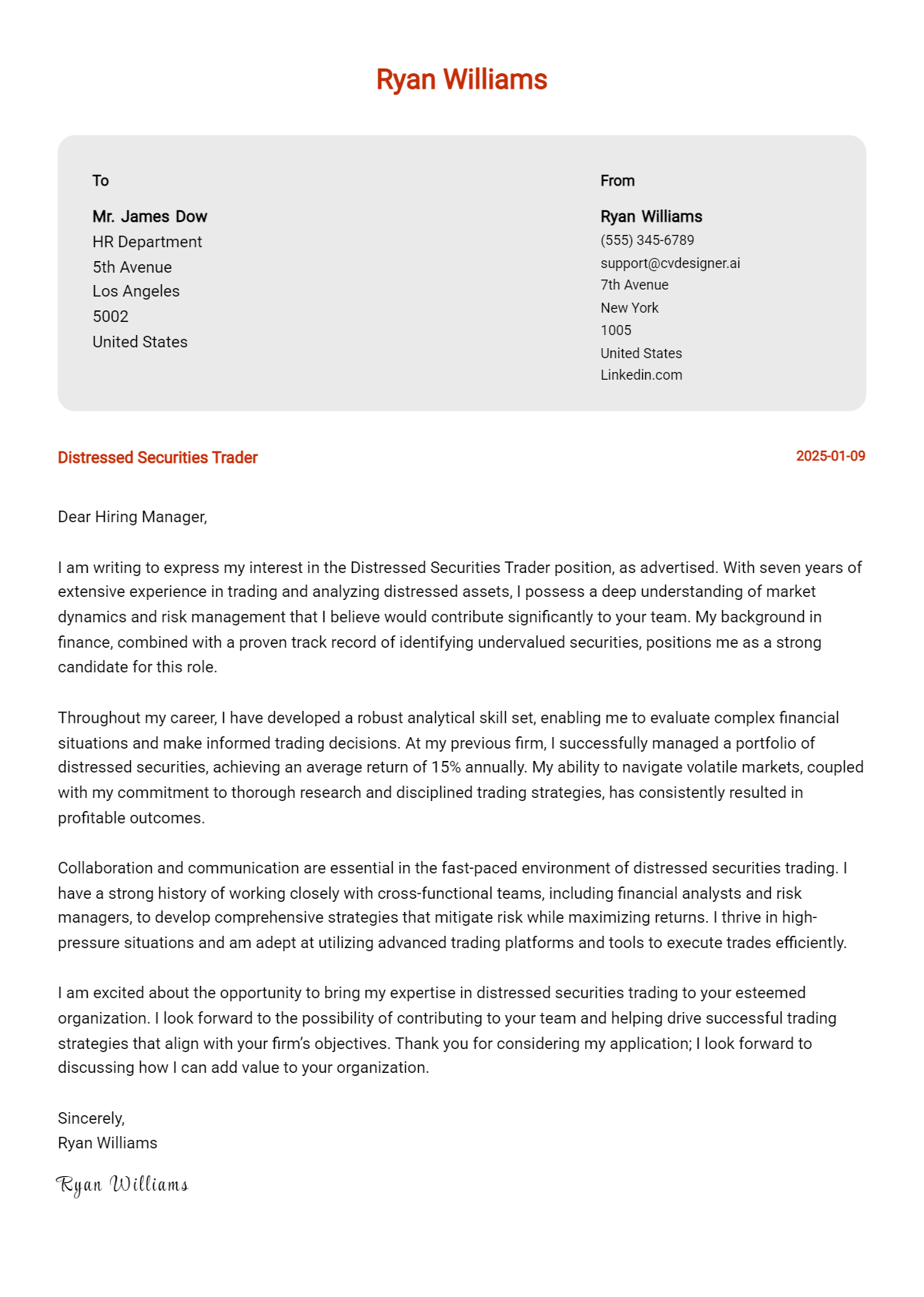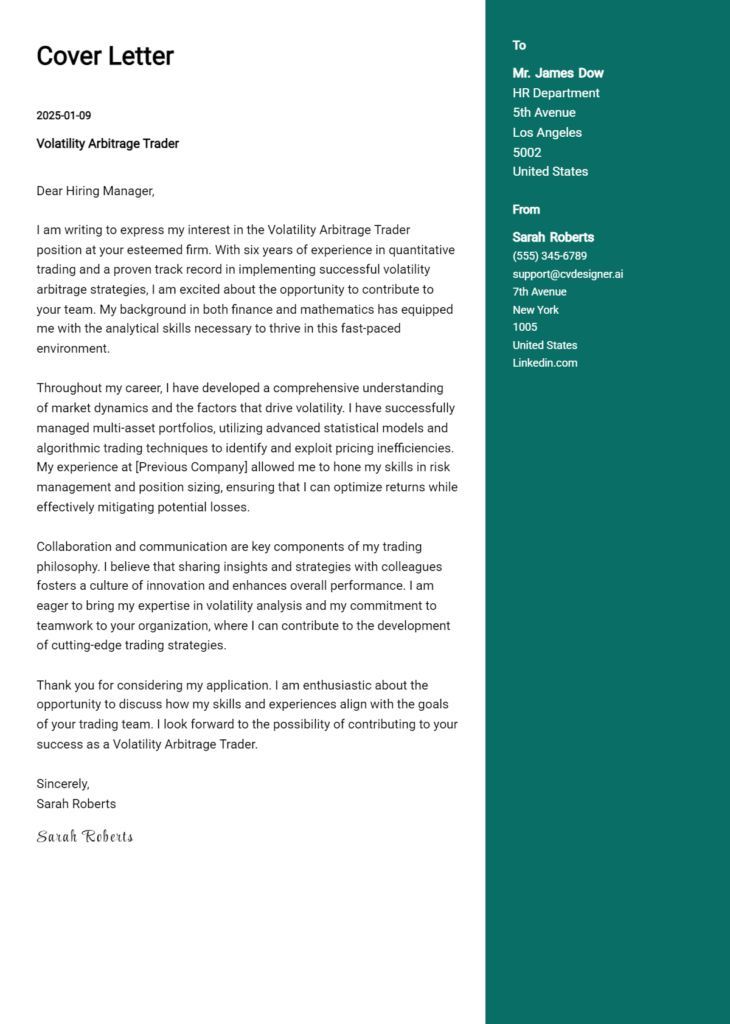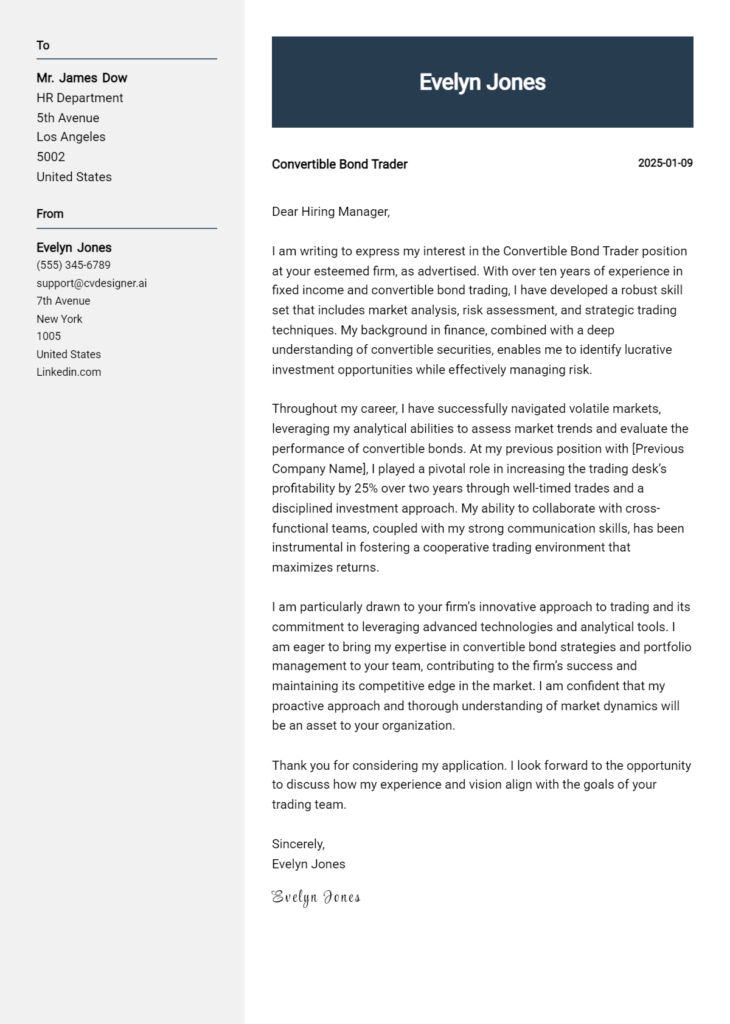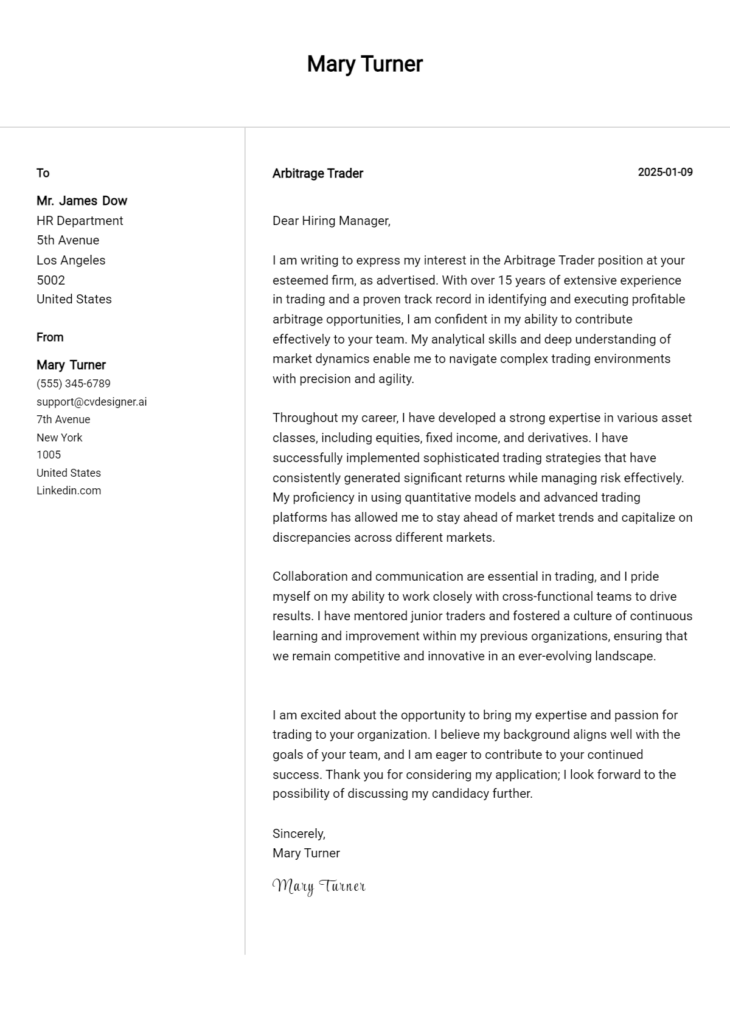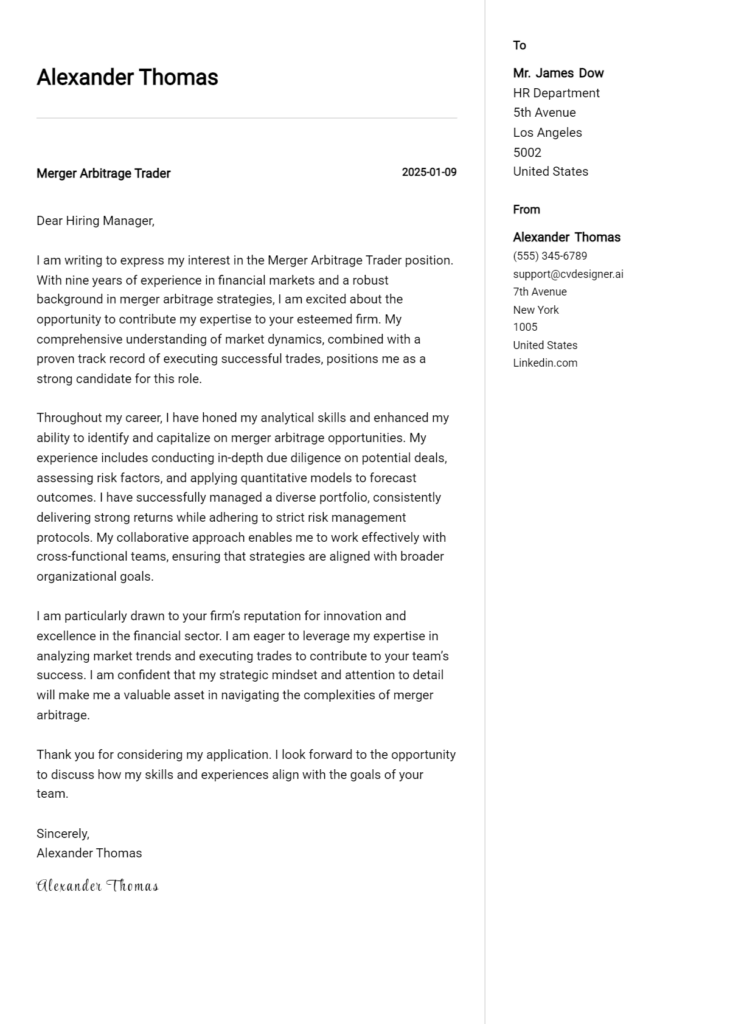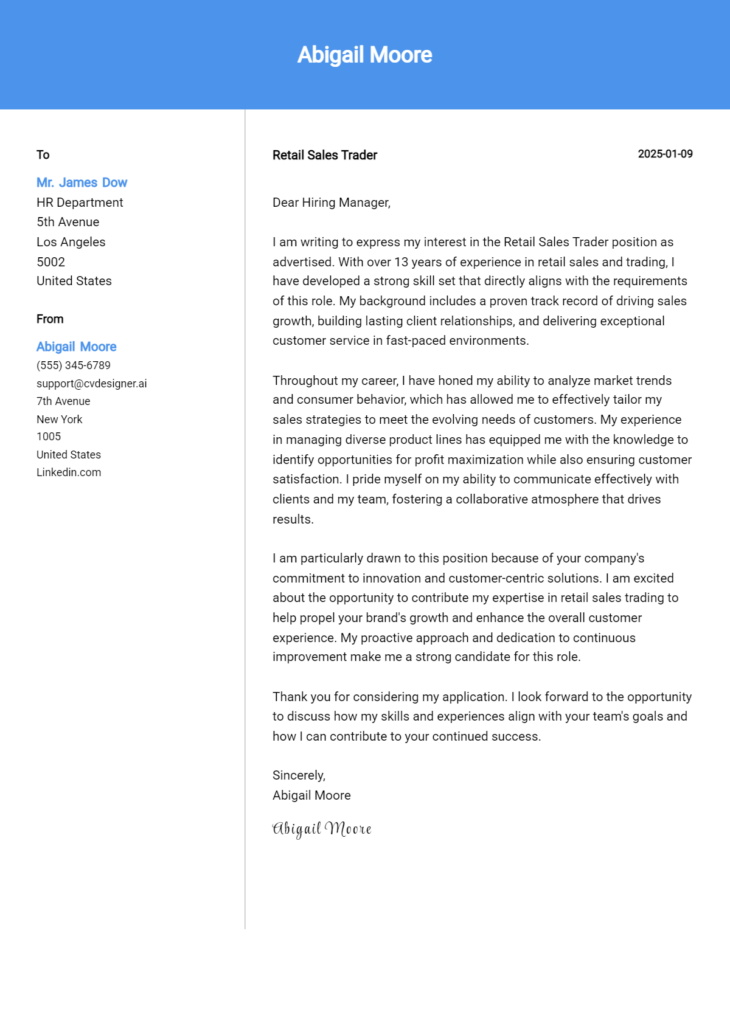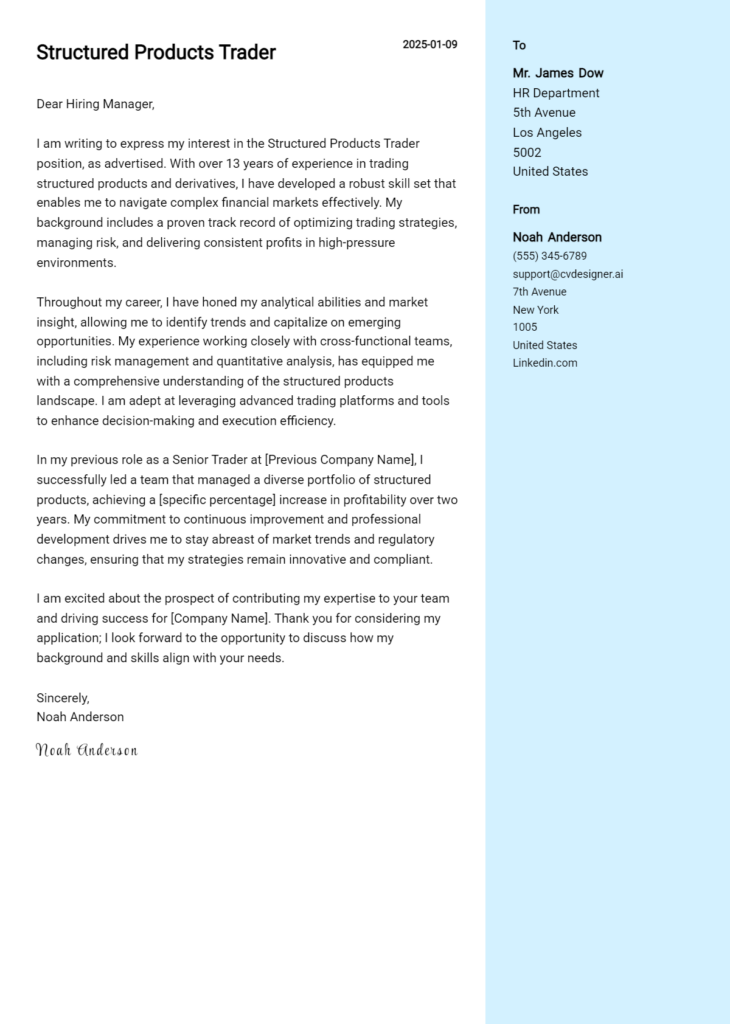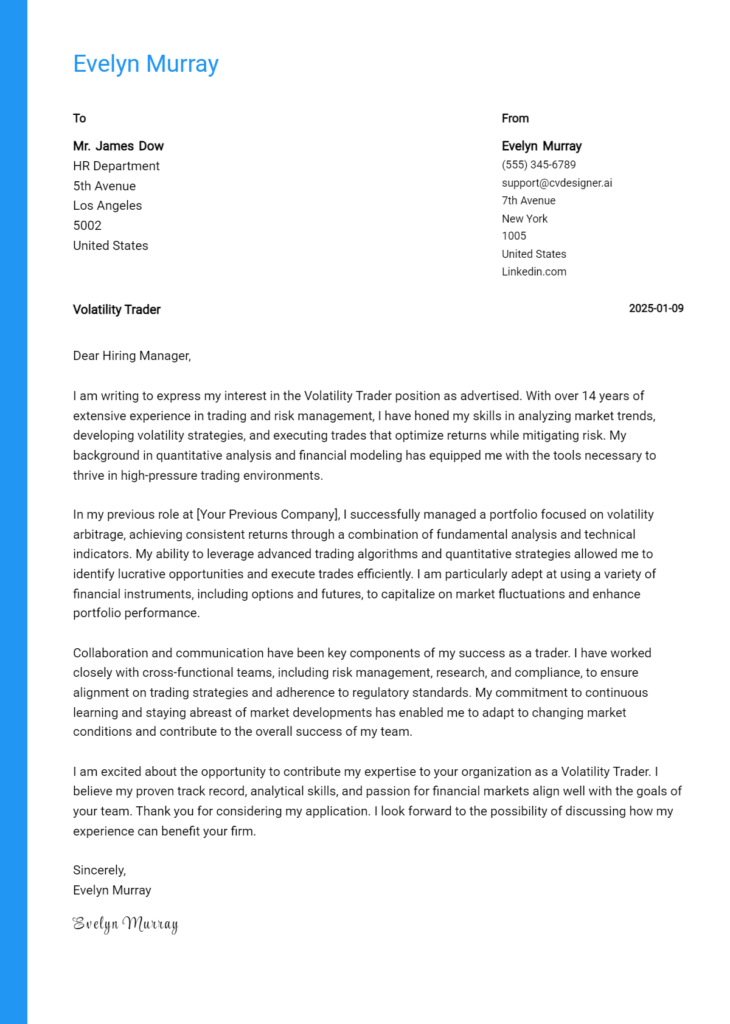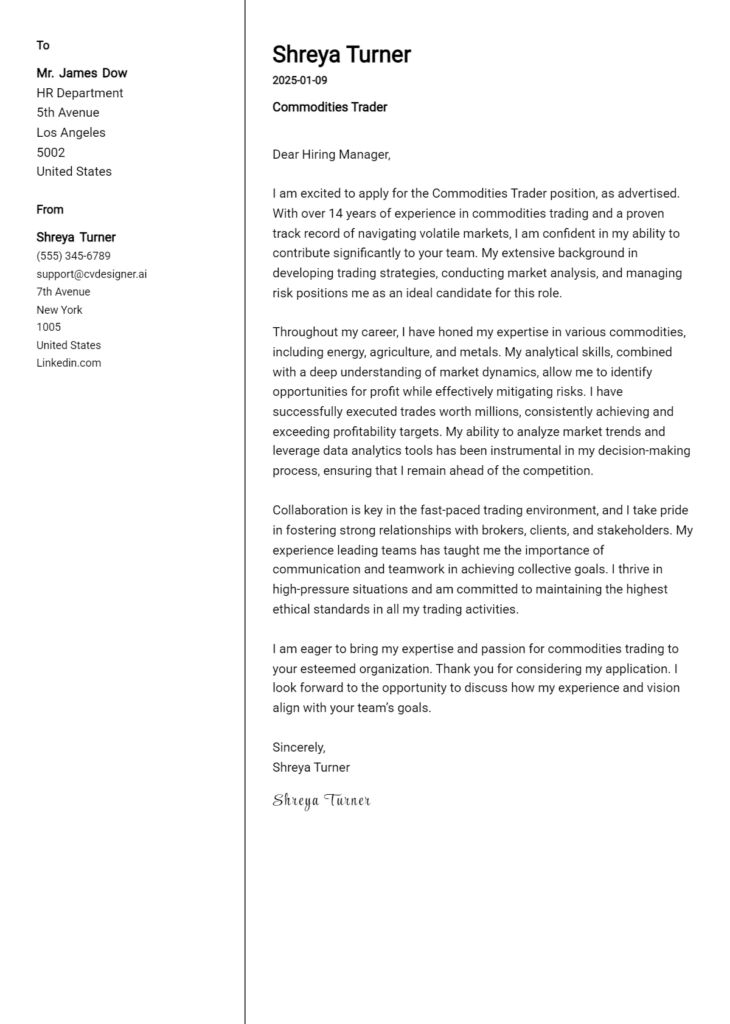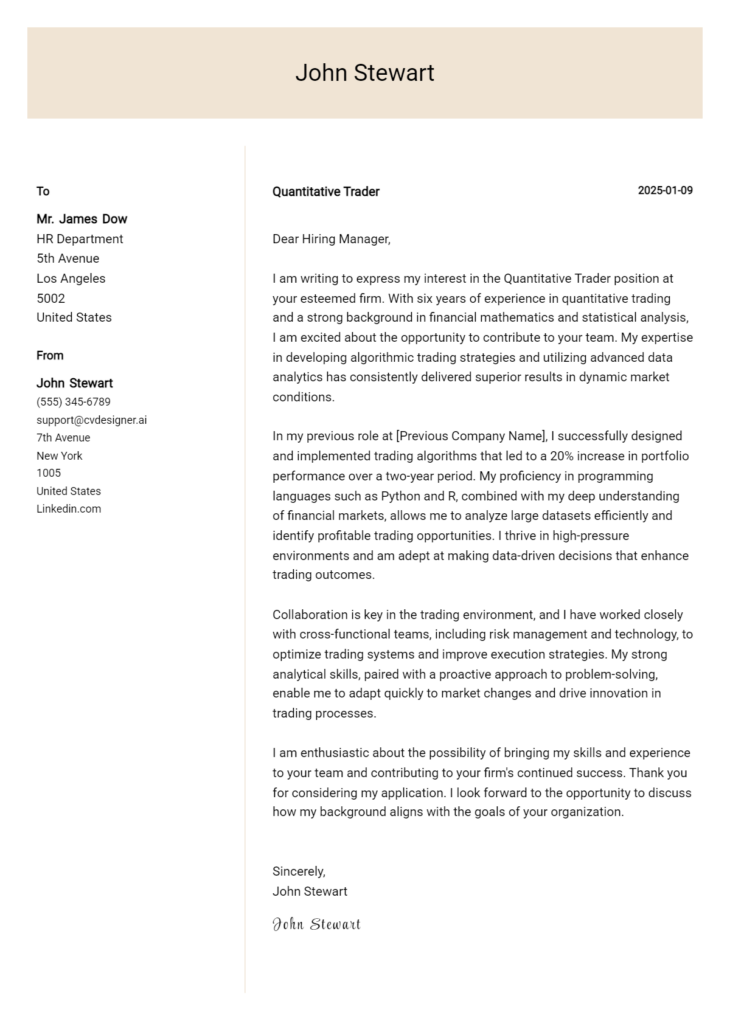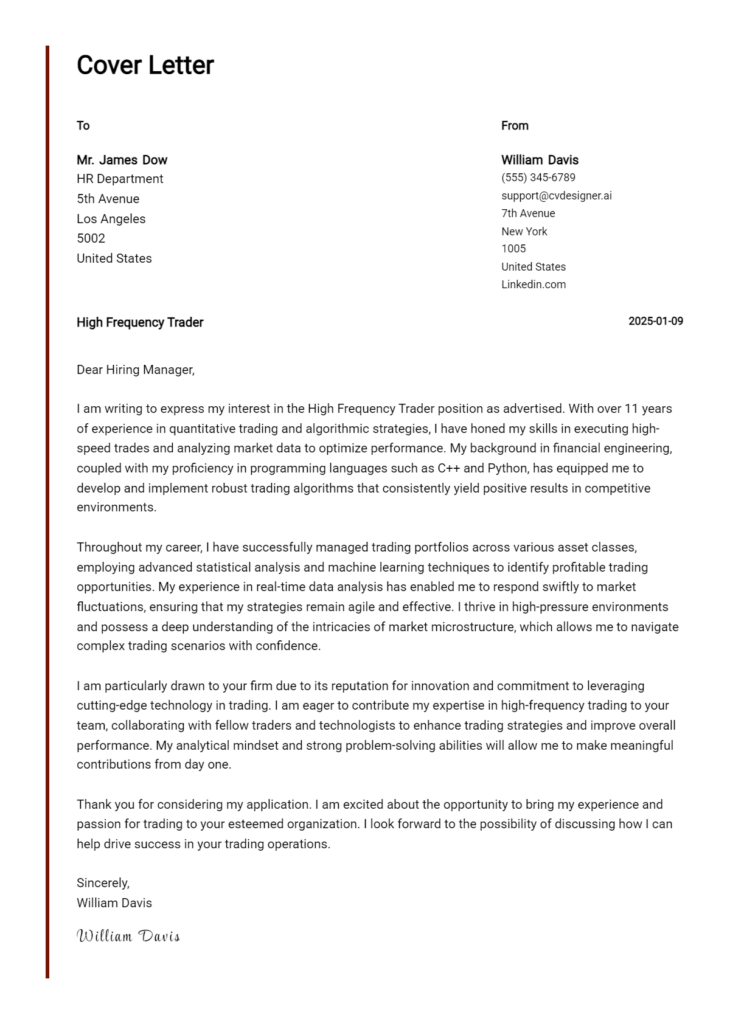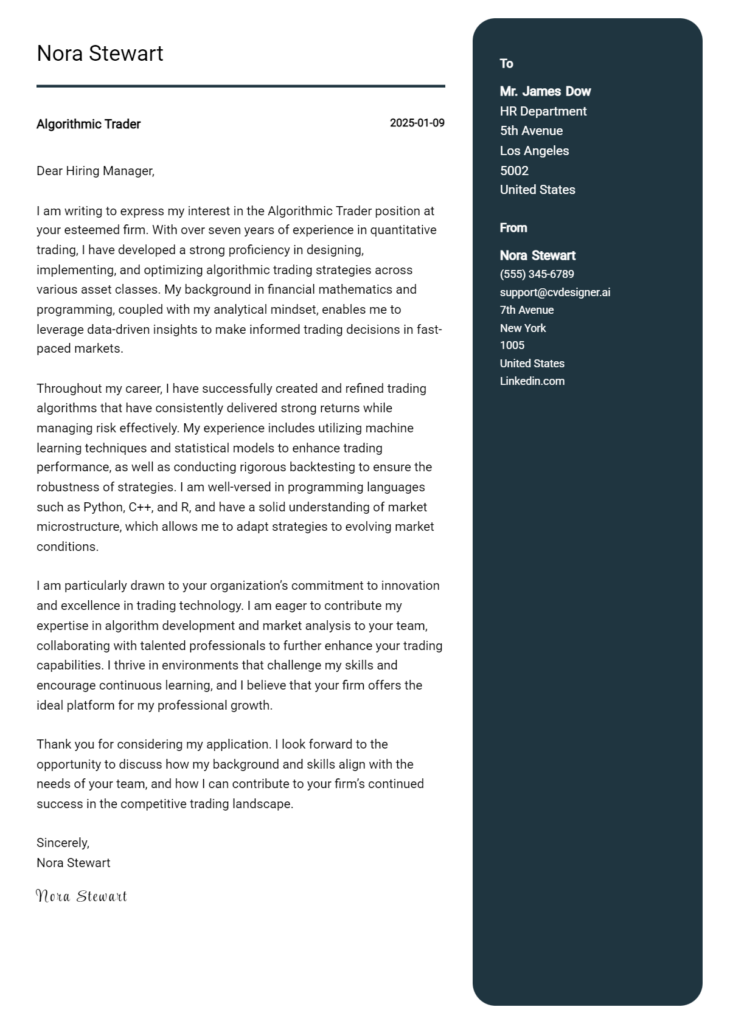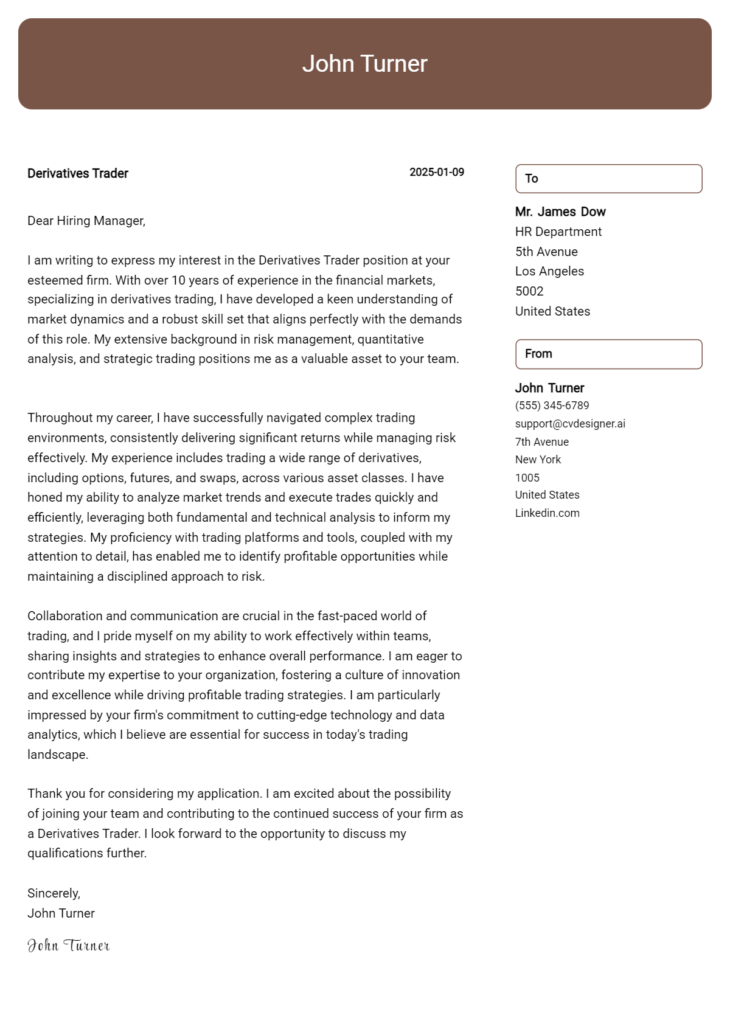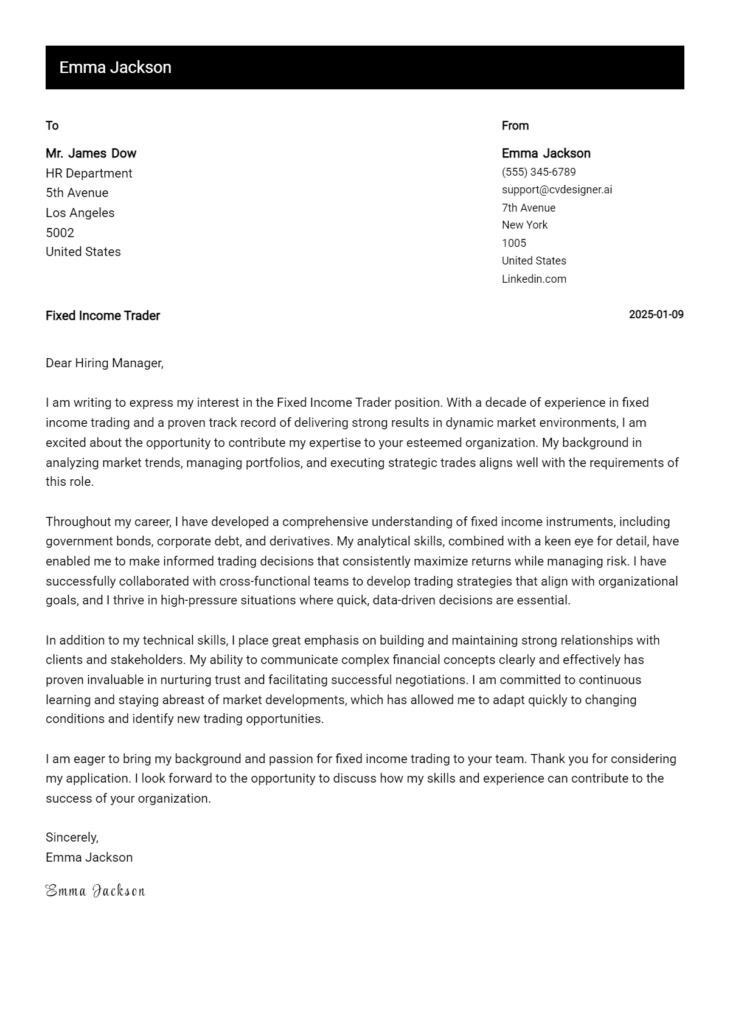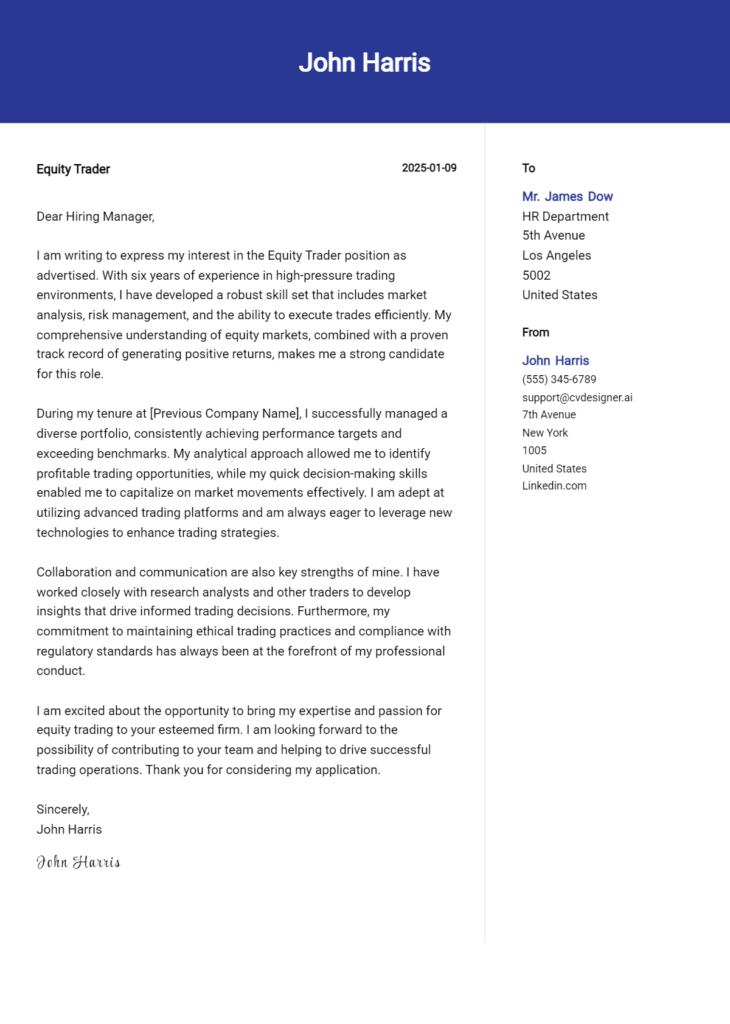Distressed Securities Trader Cover Letter Examples
Explore additional Distressed Securities Trader cover letter samples and guides and see what works for your level of experience or role.
How to Format a Distressed Securities Trader Cover Letter
Crafting a compelling cover letter for a Distressed Securities Trader position requires more than simply listing your financial acumen and trading experience. The formatting of your cover letter plays a significant role in demonstrating your analytical skills, attention to detail, and ability to navigate complex investment landscapes. A well-structured cover letter not only captures the hiring manager's attention but also reflects your proficiency in the financial markets, particularly in distressed securities, where precision and clarity are paramount.
In this guide, we will outline the essential components of an effective cover letter tailored for a Distressed Securities Trader, including:
- Cover Letter Header
- Cover Letter Greeting
- Cover Letter Introduction
- Cover Letter Body
- Cover Letter Closing
Each section is crucial for showcasing your qualifications and professionalism. Let’s delve into each part and discuss how to make your cover letter truly stand out in the competitive field of distressed securities trading.
Importance of the Cover Letter Header for a Distressed Securities Trader
The header of a cover letter is a crucial component for a Distressed Securities Trader, as it establishes the professionalism and clarity of the application right from the start. A well-structured header not only provides essential contact information but also sets the tone for the entire letter. It should include your name, address, phone number, email address, the date, and the recipient's details (name, title, company, and address). This clarity ensures that the hiring manager can easily reach out to you and shows that you understand the importance of organization and detail—key traits for success in trading distressed securities.
Strong Example
John Doe 123 Wall Street New York, NY 10005 (555) 123-4567 johndoe@email.com October 5, 2023 Mr. Richard Smith Head of Recruitment ABC Capital Management 456 Financial Avenue New York, NY 10010
Weak Example
John D. NY 555-1234 johndoe@email 10/5/23 To Whom It May Concern,
The Importance of a Cover Letter Greeting
The greeting of your cover letter sets the tone for the rest of your application, establishing a level of professionalism and personalization that can significantly impact how your candidacy is perceived. By directly addressing the hiring manager, you demonstrate respect and a genuine interest in the position, which can create a favorable impression right from the start. Avoiding generic greetings, such as "To Whom It May Concern," is crucial; instead, take the time to research and find the recipient's name. This small effort reflects your attention to detail and your commitment to the role, particularly in a competitive field like distressed securities trading.
Strong Greeting Example
Dear Mr. Smith,
Weak Greeting Example
To Whom It May Concern,
The Importance of a Strong Cover Letter Introduction for a Distressed Securities Trader
A well-crafted cover letter introduction is crucial for a Distressed Securities Trader as it serves as the first impression to the hiring manager. This opening paragraph should not only capture their attention but also convey the candidate's genuine interest in the position. Additionally, it should briefly highlight key skills or achievements that align with the demands of the role. A strong introduction sets the tone for the rest of the application, showcasing the candidate's understanding of the market and their capability to navigate complex financial situations. Below are examples of both a strong and a weak introduction for a cover letter tailored to this role.
Strong Example
Dear [Hiring Manager's Name], As a seasoned Distressed Securities Trader with over seven years of experience navigating volatile markets, I am excited to apply for the position at [Company Name]. My proven track record of identifying undervalued assets and executing timely trades has resulted in an average portfolio return of 15% annually, even in challenging economic climates. I am particularly drawn to the opportunity at [Company Name] because of your commitment to innovative investment strategies, and I am eager to contribute my expertise to your team.
Weak Example
Hello, I am writing to express my interest in the Distressed Securities Trader position. I have some experience in trading and think it would be a good job for me. I’ve done a bit of work with distressed assets and I hope you consider my application.
Purpose of the Cover Letter Body for a Distressed Securities Trader
The cover letter body for a Distressed Securities Trader serves as a crucial section where candidates can effectively communicate their relevant skills, experiences, and the unique value they bring to the company. This segment allows the candidate to highlight specific projects or accomplishments that demonstrate their ability to navigate complex financial landscapes, manage risk, and identify lucrative investment opportunities in distressed assets. By detailing relevant experiences, such as successful trades or strategies implemented during market downturns, the candidate can establish credibility and showcase their analytical skills, which are essential in this niche field.
Strong Example
I have successfully navigated the distressed securities market over the last five years, during which I managed a portfolio that delivered a 20% return in a year marked by significant volatility. One of my most notable accomplishments was identifying and investing in a distressed manufacturing firm that was undervalued due to temporary operational setbacks. By conducting thorough due diligence and implementing a turnaround strategy, I not only recovered my initial investment but also generated a profit of 35% within 18 months. My proactive approach to risk assessment and my ability to make informed decisions under pressure have consistently resulted in superior investment outcomes, making me a valuable asset to your trading team.
Weak Example
I have worked in finance for a few years and know a bit about trading distressed securities. I once invested in a company that was having some problems. I think I did okay, but I can't remember the details. I am interested in your company and hope to do well if hired. I am a hard worker and can learn quickly.
Importance of the Cover Letter Closing for a Distressed Securities Trader
The closing paragraph of a cover letter for a Distressed Securities Trader is crucial as it serves to summarize your qualifications, reiterate your enthusiasm for the position, and encourage the hiring manager to take the next steps—such as reviewing your resume or scheduling an interview. A strong closing not only leaves a positive impression but also reinforces your fit for the role, while a weak closing may fail to convey your genuine interest or leave an unclear call to action.
Strong Example
In conclusion, my extensive experience in distressed asset analysis, combined with my proven track record of generating significant returns for clients, positions me as an ideal candidate for the Distressed Securities Trader role at [Company Name]. I am genuinely excited about the opportunity to contribute to your team and leverage my skills in a dynamic trading environment. I look forward to the possibility of discussing my application further and am eager to share how I can add value to your organization. Thank you for considering my candidacy; I hope to speak with you soon.
Weak Example
To sum up, I have some experience in trading and think I could do well at this job. I hope you look at my resume. If you want to talk, that would be fine. Thanks for your time.
Cover Letter Writing Tips for Distressed Securities Trader
Crafting an effective cover letter for a Distressed Securities Trader position is crucial in making a strong first impression on potential employers. This role demands not only a solid understanding of financial markets but also a robust set of technical skills, problem-solving abilities, and a keen grasp of the Software Development Life Cycle (SDLC). Additionally, showcasing your capacity for teamwork and a passion for continuous learning will set you apart in this competitive field. Here are five tips to help you create a compelling cover letter:
Highlight Technical Skills:
Make sure to emphasize your proficiency with financial modeling, quantitative analysis, and relevant software tools like Bloomberg or MATLAB. Mention specific techniques you have mastered, such as risk assessment and valuation models, to demonstrate your readiness for the complexities of distressed securities trading.Showcase Problem-Solving Abilities:
Illustrate your problem-solving skills by providing examples of how you have navigated challenging situations in previous roles. Discuss scenarios where you identified investment opportunities in distressed assets or came up with innovative strategies to mitigate risk. Quantify your impact when possible to add weight to your claims.Demonstrate SDLC Knowledge:
If the role involves any technical trading systems or platforms, mention your familiarity with the SDLC. Discuss how you have contributed to system optimizations or participated in the development and testing phases of trading algorithms. This shows your ability to bridge finance and technology effectively.Emphasize Teamwork and Collaboration:
The ability to work well within a team is vital in trading environments. Share experiences where you collaborated with colleagues, cross-functional teams, or clients to enhance trading strategies or improve decision-making processes. Highlight your role in these collaborations to showcase your interpersonal skills.Express Passion for Continuous Learning:
The financial markets are constantly evolving, and so should your skillset. Discuss any ongoing education, certifications (like CFA or CAIA), or relevant workshops you have attended. Mention your commitment to staying updated with market trends and your enthusiasm for learning about new trading technologies or strategies.
By incorporating these elements into your cover letter, you will present yourself as a well-rounded candidate equipped to tackle the challenges of a Distressed Securities Trader role.
Common Mistakes to Avoid in a Distressed Securities Trader Cover Letter
Crafting a compelling cover letter is essential for standing out in the competitive field of distressed securities trading. Avoiding common mistakes can significantly enhance your chances of making a positive impression on potential employers. Here are several pitfalls to steer clear of:
Generic Language: Using vague phrases like "I am a hard worker" doesn't showcase your skills. Instead, tailor your letter to highlight specific experiences relevant to distressed securities trading.
Lack of Quantifiable Achievements: Failing to include concrete results can weaken your case. Use metrics and examples to demonstrate your success, such as percentage returns on investments or successful trades.
Neglecting Industry Knowledge: Not showcasing your understanding of distressed securities can signal a lack of seriousness. Include insights on current market trends or notable cases to show your expertise.
Ignoring the Job Description: Not aligning your cover letter with the job requirements can make it seem unfocused. Carefully read the job description and match your skills and experiences to the key qualifications.
Overly Formal or Casual Tone: Striking the right balance in tone is crucial. Avoid using overly formal jargon or a casual style; aim for a professional yet approachable voice.
Typos and Grammatical Errors: Simple mistakes can undermine your professionalism. Always proofread your letter or ask someone else to review it before submission.
Failing to Express Genuine Interest: A lack of enthusiasm for the position can be off-putting. Show your passion for distressed securities trading and explain why you are drawn to this specific role and company.
By avoiding these mistakes and focusing on your unique qualifications, you can create a compelling cover letter that captures the attention of hiring managers.
Cover Letter FAQs for Distressed Securities Trader
What should I include in my cover letter for a Distressed Securities Trader position?
In your cover letter, highlight your understanding of distressed securities, including the factors that affect their pricing and market behavior. Detail your analytical skills and experience in financial modeling, risk assessment, and portfolio management. Mention any relevant certifications, such as the CFA or Series 7, and elaborate on your experience with distressed assets, including any specific trades you've executed. Use quantitative examples to illustrate your success in identifying investment opportunities and managing risk. Finally, convey your passion for the financial markets and your motivation for working with distressed securities, showcasing your ability to thrive in high-pressure environments.
How can I demonstrate my analytical skills in a cover letter?
To demonstrate your analytical skills, provide specific examples of projects or trades where you successfully analyzed market trends or financial statements of distressed companies. Discuss how you used data to identify profitable opportunities or mitigate risks in your trading strategies. Include metrics like return on investment or percentage gains achieved from distressed trades to quantify your success. Additionally, mention any software or tools you are proficient in, such as Bloomberg or Excel, that you utilized for data analysis. This evidence not only showcases your technical abilities but also reinforces your capability to make informed decisions in a challenging market.
Should I tailor my cover letter for each application?
Yes, tailoring your cover letter for each application is crucial, especially in the competitive field of distressed securities trading. Research the firm’s investment philosophy, recent deals, and market outlook to align your skills and experiences with their needs. Customizing your cover letter demonstrates your genuine interest in the position and the firm, while also highlighting how your background makes you a suitable candidate. Use specific language and examples that resonate with the firm's focus areas or recent initiatives. This personalized approach can set you apart from other candidates and show your commitment to contributing to their team.
How do I convey my understanding of market conditions in my cover letter?
To convey your understanding of market conditions, reference recent trends in distressed securities and how they impact investment strategies. Discuss economic indicators, regulatory changes, or geopolitical events that influence the market landscape. You can mention specific sectors or companies that are currently facing distress and how you would approach trading in those contexts. Incorporating recent case studies or market analysis into your cover letter showcases your proactive engagement with the industry. This not only demonstrates your knowledge but also reflects your ability to anticipate market movements, making you a valuable asset for potential employers.
Build your Cover Letter in minutes
Use an AI-powered cover letter builder and have your letter done in 5 minutes. Just select your template and our software will guide you through the process.

